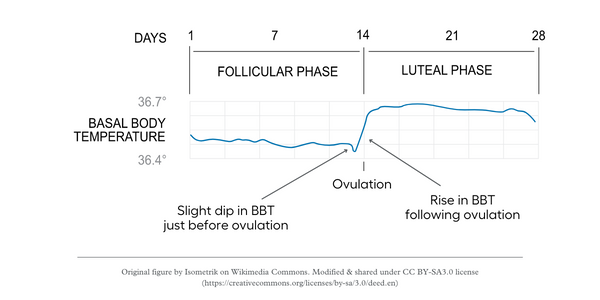If you are learning about your fertility, you may have heard about basal body temperature, also known as BBT. It’s the body’s resting temperature, which can be measured as soon as you wake up in the morning. Many women track their basal body temperature to identify their fertile days within their cycles.
But how does tracking your basal body temperature help you find your fertile window? And how do you actually measure and interpret your BBT?
Let’s dive into how the basal body temperature method works, what factors affect your resting temperature, how to actually measure your BBT, and more.
What Is Basal Body Temperature?
The basal body temperature method – a fertility awareness-based method – is a form of natural family planning that only requires an accurate thermometer. While some women use the BBT method to avoid getting pregnant, it can be a useful tool to understand your fertility and accelerate the process when you are trying.
The basal body temperature tracking helps you predict when you are going to ovulate by tracking changes in your body temperature throughout your menstrual cycle. Through thermoregulation, human bodies maintain a relatively narrow range of core body temperatures.
However, ovulation is usually followed by a slight increase in the core body temperature.
This is due to an increase in the hormone progesterone, which is secreted by the corpus luteum, the empty ovarian follicle that contains the just-ovulated egg. This upward shift in resting body temperature can pinpoint where you are in your cycle.
The basal body temperature method can be even more powerful when combined with other fertility awareness-based methods like cervical mucus tracking, or at-home ovulation tracking kits.
How Can I Use the BBT Method To Track Ovulation?
Many women report basal body temperatures of 97°F to 97.5°F in the first half of their menstrual cycle. Then, following a slight dip, your basal body temperature rises slightly about 24 hours after ovulation and stays elevated for several days.
After the egg is released at ovulation, many women find their BBT increases from 97.6°F to 98.6°F. The rise can be smaller – some women see just half a degree of BBT increase.
With all that said, as every body is different, there is no “normal” basal body temperature to reference. Rather than looking for a specific temperature, you should look for your own pattern of dips and rises throughout your cycle. After a few cycles of BBT tracking, you will be able to estimate when your fertile window opens and closes, based on your BBT pattern.
Because sperm can live up to five days inside the female reproductive tract, you have a chance of getting pregnant if you have sexual intercourse up to four to five days before the egg is released. This is the start of your fertile window.
After ovulation your egg can live for only 12 to 24 hours. After that, the chances of getting pregnant are low until the following month. This closes your fertile window.
Check your basal body temperature every day for a few cycles. Once you start seeing your pattern, you can more easily predict the day of ovulation every month to better track your fertility window.
How To Take Your Basal Body Temperature
Tracking your BBT (basal body temperature) is a simple process, but there are a few things to keep in mind to ensure an accurate reading.
1. Get the Right Tools
When tracking your ovulation with the basal body temperature method, you will be looking for small changes in body temperature. To do so, you will need a basal thermometer.
An essential quality of a basal thermometer is that it shows the temperature in tenths of a degree. You may want to skip a regular thermometer and use a digital thermometer instead, so that you can detect even the slightest temperature changes.
Some basal thermometers are used in the mouth, and others are used in the rectum. Rectal thermometers may be the better option to get the most accurate and reliable results. Keep the thermometer in place for about five minutes (or follow the manufacturer’s instructions).
2. Stick to the Same Time of Day
A key factor in understanding your body’s pattern is to take your temperature at the same time every day. In addition to the changes associated with your menstrual cycle, your body temperature changes depending on the time of day and your activity levels. So, take your body temperature within the same 30-minute window upon waking every morning – and before doing anything else.
3. Get Enough Sleep
Make sure your body has achieved its resting body temperature by getting at least three hours of uninterrupted sleep. If you don’t get enough sleep, your body cannot reach a restful state, introducing noise to your BBT readings, which can make it difficult to learn your pattern.
4. Keep a Chart
Be sure to write down your temperature reading every single day. Although the temperature may be the same for several days in a row and you assume you will remember, it is still crucial to write it down.
Tracking your basal body temperature for ovulation means looking for tiny changes. The best way to notice patterns or changes is to compare every reading to several prior readings.
Visualizing the temperature readings on a chart is usually the easiest way to go, and there are many blank BBT charts available online for download, as well as mobile apps.
How To Interpret the Temperature
During your first cycle, you might not be able to pinpoint exactly when you are ovulating. However, after an entire month or two of tracking your daily basal body temperature, you should be able to notice slight changes that occur.

Look for times when your body temperature rises about ½ to 1°F and see if it remains steady over the next few days. Then, look at the temperatures recorded a few days before the spike. These few days before the BBT spike are your most fertile period in the cycle.
Were those temperatures consistent and slightly lower or higher than usual?
Once you have a better understanding of what your basal body temperature dips and spikes look like, you will be able to know when your ovulation happened each cycle and predict your fertile window that precedes ovulation.
Also, it is important to note down any daily factors, like stress or illness, which can cause a change in basal body temperature. Make a note of these factors on your BBT chart so that you can take them into account when interpreting your BBT chart.
When you notice a slight dip in your BBT, that is the best time to have sex for a pregnancy. Consider this timeline as your fertility window, leading up to ovulation.
What To Use for Basal Body Temperature Tracking
When you are trying to get pregnant, tracking your BBT’s daily changes can be a powerful way to track ovulation, estimate your fertile window and plan sexual intercourse. If you are looking for a hands-on, low-cost solution, make sure your BBT thermometer can read down to 1/10 of a degree (F). Digital is the way to go here.
Tracking BBTs manually can have its drawbacks, though - such as having to spend time learning how to interpret your chart, or having to wake up at the same time every day (including the weekend!). However, there are a few modern BBT-based fertility trackers that solve many of the problems of the traditional BBT method.
Tempdrop Fertility Monitor
When it comes to fertility awareness, not all methods have the same effectiveness, and not all methods work in the same way. For example, you may find methods that work by predicting ovulation based on cycle length do not identify with your specific ovulation in the same way that measuring BBT does.
This is because counting the cycle days can only give an estimate as to when ovulation occurs, based on what’s considered “average.” Only a minority of women have the “average” 28-day cycle, so a method that relies on a 28-day cycle can be misleading to a majority of women whose cycles are longer or shorter. In contrast, a proper temperature reading can confirm when ovulation has actually occurred.
The first step to getting pregnant is understanding your fertile window. With a modern, app-enhanced BBT tracker like the Tempdrop Fertility Monitor, you can track your BBT to help time intercourse and maximize your chance of conception.
An FDA-registered fertility monitor, Tempdrop detects your fertility window through the cyclical changes in body temperature. After each reading, the Tempdrop app will display your temperature, sleep data, and fertility insights. (Some of the features require a Premium subscription.)
You wear the Tempdrop sensor to bed and remove the monitor before you get up for the day. The data is synched with the Tempdrop app, whenever it’s convenient for your schedule. No need to get up at the same time every day and measure and record your temperature. Once you’ve entered your symptoms into the app to verify ovulation, you can view your personalized cycle chart and results to know when you’re most fertile.
Conclusion
When it comes to fertility awareness, not all methods have the same effectiveness or fit into your daily life the same way. Some methods that try to predict ovulation based on cycle length alone, for example, cannot identify your specific day of ovulation the same way the BBT method measures - for the simple reason that your cycle is most likely different from the “average.”
Tracking your BBT over time and developing an understanding of your own cycles can help you predict when your body is likely to ovulate, increasing the chance of getting pregnant within a shorter period of time.
If you have any questions about using the BBT method to predict your fertile window, let us know. Ovaterra is here to help you support your reproductive health.













